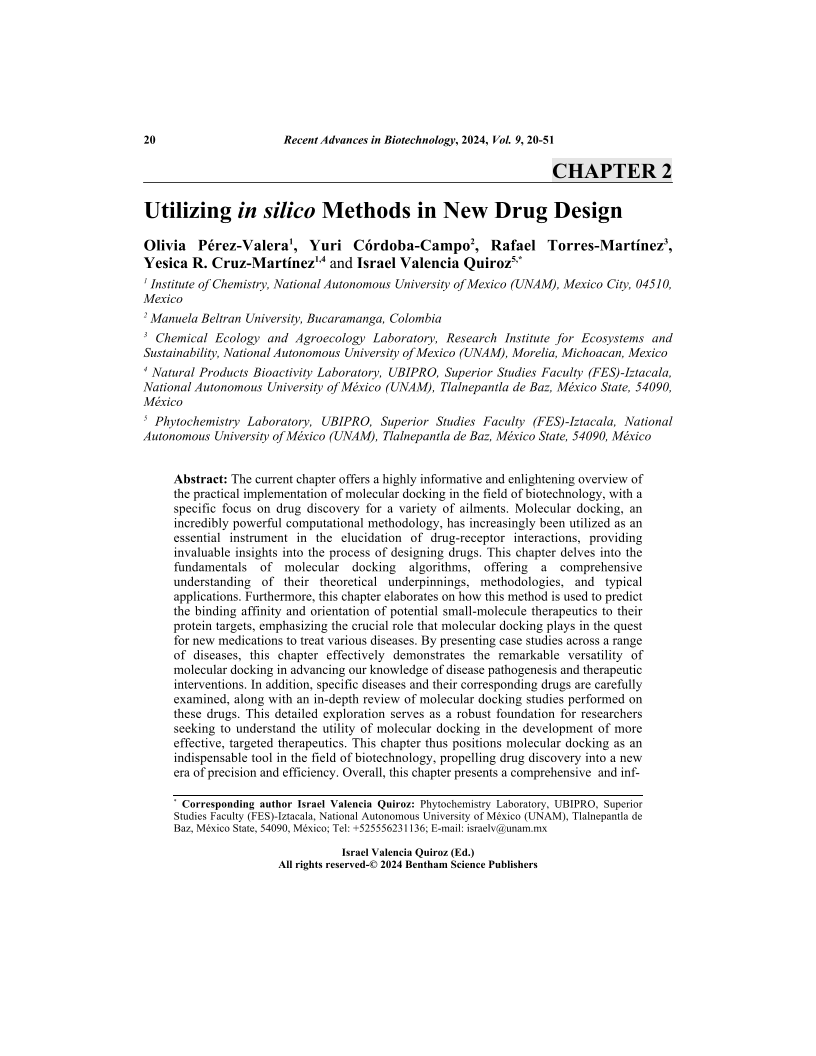Utilizing in silico Methods in New Drug Design

- Authors: Olivia Pérez Valera1, Yuri Córdoba-Campo2, Rafael Torres-Martínez3, Yesica R. Cruz-Martínez4, Israel Valencia Quiroz5
-
View Affiliations Hide Affiliations1 Institute of Chemistry, National Autonomous University of Mexico (UNAM), Mexico City, 04510, Mexico 2 Manuela Beltran University, Bucaramanga, Colombia 3 Chemical Ecology and Agroecology Laboratory, Research Institute for Ecosystems and Sustainability, National Autonomous University of Mexico (UNAM), Morelia, Michoacan, Mexico 4 Institute of Chemistry, National Autonomous University of Mexico (UNAM), Mexico City, 04510, Mexico 5 Phytochemistry Laboratory, UBIPRO, Superior Studies Faculty (FES)-Iztacala, National Autonomous University of Mxico (UNAM), Tlalnepantla de Baz, Mxico State, 54090, Mxico
- Source: Biotechnology and Drug Development for Targeting Human Diseases , pp 20-51
- Publication Date: March 2024
- Language: English
Utilizing in silico Methods in New Drug Design, Page 1 of 1
< Previous page | Next page > /docserver/preview/fulltext/9789815223163/chapter-2-1.gif
The current chapter offers a highly informative and enlightening overview of the practical implementation of molecular docking in the field of biotechnology, with a specific focus on drug discovery for a variety of ailments. Molecular docking, an incredibly powerful computational methodology, has increasingly been utilized as an essential instrument in the elucidation of drug-receptor interactions, providing invaluable insights into the process of designing drugs. This chapter delves into the fundamentals of molecular docking algorithms, offering a comprehensive understanding of their theoretical underpinnings, methodologies, and typical applications. Furthermore, this chapter elaborates on how this method is used to predict the binding affinity and orientation of potential small-molecule therapeutics to their protein targets, emphasizing the crucial role that molecular docking plays in the quest for new medications to treat various diseases. By presenting case studies across a range of diseases, this chapter effectively demonstrates the remarkable versatility of molecular docking in advancing our knowledge of disease pathogenesis and therapeutic interventions. In addition, specific diseases and their corresponding drugs are carefully examined, along with an in-depth review of molecular docking studies performed on these drugs. This detailed exploration serves as a robust foundation for researchers seeking to understand the utility of molecular docking in the development of more effective, targeted therapeutics. This chapter thus positions molecular docking as an indispensable tool in the field of biotechnology, propelling drug discovery into a new era of precision and efficiency. Overall, this chapter presents a comprehensive and informative overview of the diverse applications of molecular docking in biotechnology, providing an essential resource for researchers in the field.<br>
-
From This Site
/content/books/9789815223163.chapter-2dcterms_subject,pub_keyword-contentType:Journal -contentType:Figure -contentType:Table -contentType:SupplementaryData105

